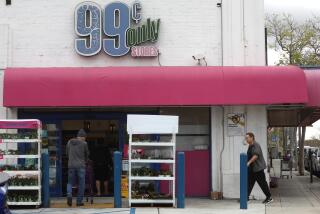Lack of Players Zaps Small Merchants : Few Are Winners in Video Arcade Game
Less than four years ago, thousands of teen-agers, their pockets bulging with quarters, flocked to video game arcades.
It brought joy to the teen-agers, to the merchants who operated the arcades and to the manufacturers of the electronic games.
Today, increased operating costs, high credit charges and a sharp decline in the public’s interest have pulled the plug on most small arcades.
The result: Of the more than 200 video arcades in San Diego County in 1982, only about 20 remain, and they have had to make drastic changes to accommodate the changing tastes of video game players.
More than half of the arcades still in operation are owned by large corporations that have the needed capital and resources, according to Joel Weinberg, president of Bordy Music and Vending Co.
Corporations Suffering However, even the corporations are suffering, Weinberg said, because fewer people are playing the games. And those who are playing are spending less money than they did a couple of years ago.
The average video game today generates less than 50% of the revenue it did in the early 1980s, said the manager of an arcade in La Jolla.
So the companies are building their arcades in high traffic areas, serving food and offering other entertainment, all of which has lured customers from smaller, privately owned arcades, he said.
Finding money to buy new and better games is the greatest problem facing the private owners, Weinberg said. The arcades owned by video game distributing companies can buy the machines at reduced prices, thereby reducing their overhead, he said.
In the early days of the industry, many operators borrowed money from video game manufacturers and distributors to buy machines at interest rates of up to 13.5%, said Weinberg.
When the public’s fascination with the games began to fade, private owners soon discovered that their shrinking income was not keeping pace with their increasing overhead and the high interest rates.
In many cases, small-business owners were left with only high loan payments and rooms full of broken machines that they could not afford to have fixed, Weinberg said.
Interest Declining But there may have been enough quarters for everyone had public interest in video games remained high, some game operators believe.
“There were enough players then that you could put a game anywhere and someone would play it,” said Jay Stein, manager of the Yellow Brick Road arcade in University Towne Centre.
Now that has changed. Decisions crucial to a successful game center involve what games to buy and where to locate. Merely hanging out an “open-for-business” sign is no longer sufficient.
Failure to consider these things could mean failure for the business, Stein said.
For example, typically, a $2,000 machine would pay for itself in about 10 weeks.
But less popular games may bring in only about $24 per week, he said, so it could take more than 18 months to pay that machine off.
Not even the larger entertainment centers are making the profits they made a few years ago, Stein said.
“The novelty just wore off the games,” he said. “We made some bad decisions about buying some games and we bit the bullet pretty hard.”
The average game in the Yellow Brick Road arcade generated about $300 per week during 1982, Stein said. Today the average game there brings in about $120 per week.
Stein said he believes the weekly average for the three Yellow Brick Road arcades in San Diego County is higher than the average for most other game centers in the county.
Weinberg said he believes the arcade business is a closed industry and advises private entrepreneurs to stay away unless they have money to buy the machines and can afford to put them in a location that people frequent.
“It’s too tough for a small guy to go in today. It’s almost impossible,” he said. “It looks easy, but it’s very complicated.”
Some private arcade owners are able to stay afloat by buying machines that offer a variety of games. A kit costing about $200 can be purchased to convert a machine from one game to a more popular one, Stein said.
Vending companies offer another alternative for private owners. For a percentage of the profit, companies will place their machines in a business--usually a bar, restaurant or supermarket.
The arrangement is relatively risk-free for the business owner, but with fewer people playing video games, vending company officials are more careful about where they will put their machines, Weinberg said.
“If we pay money for a machine, we must put it in a bar that will pay for it,” he said. “You have got to operate this business like a real business.”
More to Read
Inside the business of entertainment
The Wide Shot brings you news, analysis and insights on everything from streaming wars to production — and what it all means for the future.
You may occasionally receive promotional content from the Los Angeles Times.










